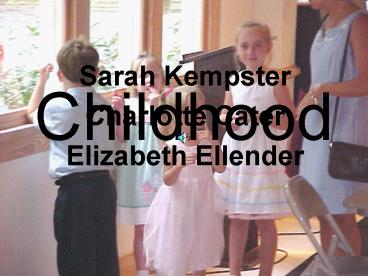Childhood - PowerPoint PPT Presentation
1 / 13
Title: Childhood
1
Childhood
- Sarah Kempster
- Charlotte Cater
- Elizabeth Ellender
2
INDEX
- Has childhood always existed?
- Youth sub-cultures
- Social Construction of childhood
- Is childhood disappearing?
- Ethnicity and childhood
- Childrens act
- Child support
3
Has Childhood always existed?
Childhood is often seen as a social
construction. In medieval society childhood was
not recognised as a separate stage of development
in life. In traditional British society (pre
1800) children were not dissimilar to adults,
Childhood developed within the construction of
capitalism in rise of maternal love and
domesticity.
19th Century legislation distinguished children
as people who were exempt from adult
responsibility
Child labour has become unnecessary in today's
society due to the embourgeoisiement in Britain
giving children a period of leisure time and
educational opportunities in the first stages of
life.
There has been a rise of children's rights in the
past century for example The children's act of
1989.
4
Youth Subcultures
- The CCCS believe that the different youth
cultures exist for adolescents to distinguish
themselves amongst mass culture. - Jefferson (1976) Teddy Boys- A group who wish
to recreate a sense of working class community-
due to the growing affluence in post war British
society- These youth cultures believed they were
gaining status and protecting territory
NEO-MARXIST
5
Each subculture aims to make a spectacle and
wants to be noticed
- Each subculture develops its own style by taking
everyday objects and transforming the meaning.
- Hebdige (1979) (some Marxist analysis but mainly
semotics)
MODS SKINHEADS CONTRASTED
6
- Skinheads had an exaggerated working class
apparel whereas the Mods created themselves as
middle class - The Mods dressed in a middle class way, however
their real interest lay in cellar clubs, botiques
and record shops- this did not represent the
conventional middle class world - The Skinheads would reflect hard working-class
men
7
Social Construction of Childhood
- Laws
- At the following ages one can
- 5- Drink alcohol in private
- 7- Draw money from a bank account
- 10-Be convicted of a criminal offence
- 13- work (restricted hours)
- 14- Go in to a pub and not drink alcohol
- 16- buy a lottery ticket, buy cigarettes, leave
school, have sex - 17- Drive a car, be sent to prison
- 18- Vote, buy alcohol
8
Historical changes in the concept of Childhood
Before 1600 At 5 a child would belong to a
world of Work, Leisure and Sex- Most of the
evidence for this comes from paintings and it is
arguable. 1700-1800 Children were an economic
asset- industrialisation in the early stages
depended on the skills of children- children
provided insurance for their parents in later
life Very little love or affection was shown to
children. Childrens wages, although small, were
an important financial benefit to a family
9
1800-1900 The financial role of children was
marginalised as industrialisation steamed
forward There were now more restrictions in
place, for example compulsory education. Middle
class children were assumed to lack competencies
of adults and were therefore in need of
protection and guidance Working class children
were thought to be born corrupt and wicked and
had to be taught and controlled 1900-1950 Childre
n became economically worthless but emotionally
priceless. Children needed love and attention and
were sheltered from the world Children had now
divided themselves in to sub-cultures that the
adult did not understand. Childhood became a time
where things were supposed to be magical and fun.
10
1950-Present day Growing awareness of childrens
rights and empowerment. Children are seen as
active families and make more of a democratic
contribution to the family through things like
housework etc. Young people form a growing
economic force in society and in the family.
Children target by commerce (trade) in own right.
THEY HAVE GUNS NOW
DONT HIT CHILDREN
11
Is childhood disappearing?
Yes Libertarians Children make a workable and
sustainable contribution to the family Children
are listened to in allegations of abuse and have
rights to divorce parents They share the same
television, clothes and food as adults Children's
interests are and should be put first in custody
and adoption cases.
Yes New Right (negative) Children are less
sheltered sue to media, television and
internet They are used to abuse and exposure to
inappropriate materials. They are becoming
parents, sports and media stars when they are
still children's themselves They are often
undisciplined and lack respect for adult
authorities e.g. police teachers and parents..
12
Is childhood disappearing?
No Marxist and feminists Childhood is an
artificial period of dependence and a form of
oppression Age patriarchy is evident in the
differential distributions of power, work,
violence and rewards within the family Toys
amplifying gender roles and commercialise
childhood Children should to be sheltered from
the realities of life e.g war and death- living
fairy tale lives may be very damaging to future
years..
No Functionalists- Children are innocent and
need protections so they are banned from adult
places and activities The complexity of society
requires a long period of socialisation, hence
schools and universities Resources spent on
children e.g toys- are specialised for their
needs They have their self contained culture
13
(No Transcript)

